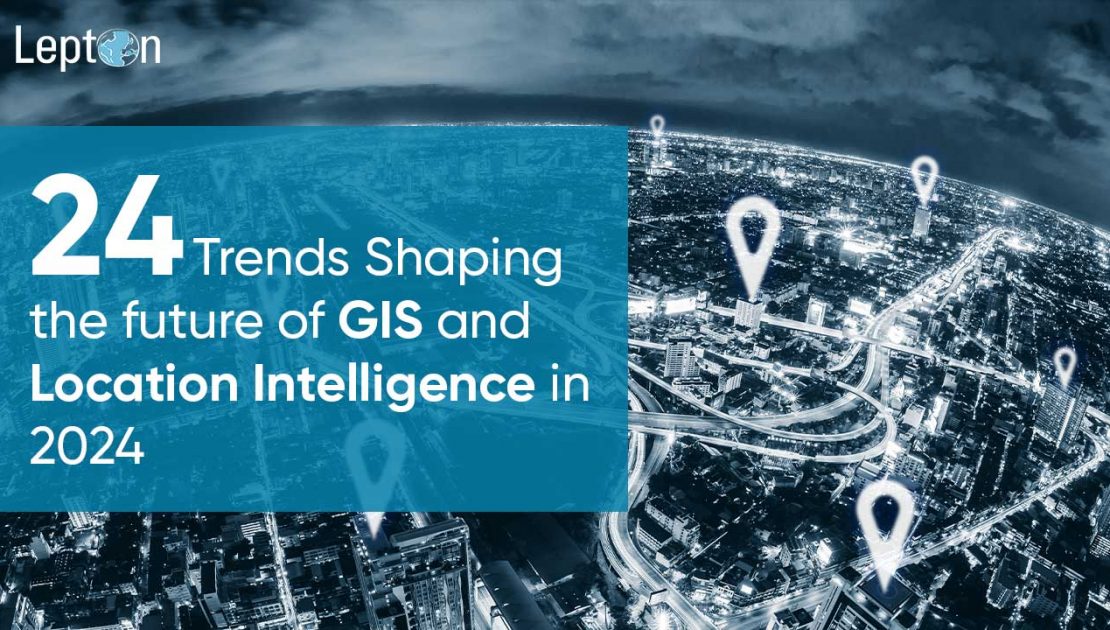24 Trends Shaping the Future of GIS and Location Intelligence in 2024

In today’s dynamic and data-driven world, geographic information systems (GIS) and location intelligence (LI) have emerged as indispensable tools for organizations across diverse industries. These technologies empower businesses to harness the power of spatial data, enabling them to gain deeper insights, make informed decisions, and optimize their operations.

As we embark on the journey towards 2024, the GIS and LI landscape is poised for exciting advancements, propelled by technological innovations, evolving data dynamics, and expanding applications.
So let’s have a look at some amazing 24 trends which will shape the future of location intelligence in 2024.
Data
Data Quality and Accuracy
Securing dependable insights requires stringent data management, validation methods, and strong governance structures. Notably, 80% of organizations note data quality challenges affecting decision-making. Implementing effective data quality initiatives can cut errors by half and boost ROI by 20%.
Exponential Data Growth
Handling the data overflow involves leveraging inventive solutions such as cloud-based storage, AI-driven analysis, and scalable infrastructure. Notably, the location data market is projected to hit $85 billion by 2027, growing at a CAGR of 24.6%.
Data Governance for Responsible Use
Establishing trust and transparency involves implementing clear data governance policies that address privacy concerns and uphold ethical practices. Notably, 75% of consumers express worries about their location data usage, and instituting transparent policies can boost trust by 60%.
Technological Advancements
Cloud-Native GIS Solutions
Utilizing scalability, flexibility, and cost-effectiveness for adaptive access and dynamic resource allocation. The cloud-based GIS market is projected to achieve $12 billion by 2027, growing at a CAGR of 23.2%.
AI and ML for Data-Driven Insights
Streamlining tasks, uncovering significant patterns, and producing predictive insights to facilitate well-informed decision-making. Notably, 80% of organizations plan to invest in AI and ML for location data analysis in the next two years, anticipating a 70% task automation and a 50% enhancement in data insights.
Immersive Experiences with AR and VR
Revolutionizing interaction with location data via augmented reality overlays and immersive virtual simulations. The global AR/VR market for GIS applications is projected to hit $5 billion by 2027, growing at a CAGR of 42.5%.
Expanding Applications
Addressing Climate Change
Overseeing environmental shifts, evaluating climate risks, and devising sustainable solutions through GIS and LI. GIS and LI applications can contribute to a 20% reduction in greenhouse gas emissions and a 15% increase in renewable energy production. Notably, 70% of government agencies are employing GIS and LI for climate change initiatives.
Enhancing Public Health
Enabling disease surveillance, swift outbreak response, optimal resource distribution, and fair healthcare access via GIS and LI. The utilization of GIS and LI can lead to a 30% reduction in disease outbreaks and a 20% improvement in healthcare accessibility. Remarkably, 80% of public health departments leverage GIS and LI for disease surveillance and control.
Optimizing Urban Planning
Fostering livable and sustainable communities by optimizing transportation networks, designing infrastructure, and managing land use through data-driven approaches. The global GIS and LI market for urban planning applications is anticipated to reach $5.8 billion by 2027, growing at a CAGR of 18.3%. Notably, 80% of cities utilize GIS and LI to enhance traffic flow, design smart infrastructure, and build livable communities.
Revolutionizing Retail
Tailoring marketing campaigns, optimizing store locations, streamlining supply chains, and elevating customer experience through location-based insights. The global location-based marketing market is projected to hit $47 billion by 2027, growing at a CAGR of 23.5%. Notably, 70% of consumers express willingness to receive personalized offers and promotions based on their location.
Empowering Agriculture
Deploying precision farming practices with GIS and LI to enhance crop yields, decrease water usage, and optimize resource management. Precision agriculture utilizing GIS and LI can boost crop yields by 15% and cut water usage by 20%. Notably, 50% of agricultural businesses leverage GIS and LI for precision farming practices.
Enhancing Disaster Preparedness
Decreasing response times, saving lives, and enhancing disaster management via GIS and LI-powered risk assessment, planning, and communication. GIS and LI applications can trim disaster response times by 30% and contribute to saving lives. Significantly, 90% of emergency management agencies utilize GIS and LI for disaster preparedness and response.
Beyond the Horizons
Integration with IoT and Sensor Networks
Integrating IoT and sensor networks with GIS and LI platforms unlocks opportunities for real-time environmental monitoring, predictive maintenance, and location-aware services. The global IoT sensor market is projected to reach $1.1 trillion by 2025, growing at a CAGR of 14.3%, with 60% of organizations planning to integrate IoT data into GIS and LI operations within the next two years.
Location-Based Marketing and Advertising
Enhancing customer engagement through personalized and targeted advertising campaigns fueled by individual location data. The global location-based advertising market is anticipated to hit $25 billion by 2027, growing at a CAGR of 20.5%. Notably, location-based advertising campaigns can achieve click-through rates three times higher than traditional advertising.
The Rise of Location-Based Services
Revolutionizing interactions with the environment via navigation apps, ride-sharing platforms, and other location-aware services. The global market for location-based services is projected to reach $120 billion by 2027, growing at a CAGR of 19.2%.
Open Data Initiatives
Encouraging innovation and collaboration through expanded access to open data for public use and research. This trend, fostering transparency and citizen participation, unlocks new possibilities for location-based applications. The global market for open data solutions is projected to reach $18 billion by 2027, growing at a CAGR of 17.5%.
Focus on Geospatial Data Standards
Advocating for interoperability and collaboration through the adoption of standardized data formats for location data. This facilitates smooth data sharing and analysis across diverse platforms and organizations. The global market for geospatial data standardization solutions is anticipated to hit $2.5 billion by 2027, growing at a CAGR of 17.8%.
Skills Development and Training
Meeting the rising demand for GIS professionals by dedicating resources to skills development programs and training initiatives. This guarantees a future workforce with the essential knowledge to harness the full potential of GIS and LI. The global market for GIS training and certification is projected to reach $1.2 billion by 2027, growing at a CAGR of 18.3%.
The Rise of Citizen Science
Involving the public in data collection and analysis through citizen science initiatives, fostering environmental monitoring, biodiversity conservation, and community empowerment. The number of global citizen science projects has surged by 200% in the last five years, with 70% of citizens expressing willingness to participate in projects relevant to their communities.
Promoting Location Intelligence Literacy
Increasing awareness and comprehension of location intelligence across diverse disciplines, providing individuals and organizations with the essential skills to harness the potential of location data for informed decision-making. The global market for location intelligence education and awareness programs is projected to reach $500 million by 2027, growing at a CAGR of 21.8%. Notably, 80% of business leaders consider location intelligence literacy crucial for effective decision-making in their organizations.
Ethical Considerations
Addressing Privacy Concerns
Prioritizing transparency, user consent, and strong data security measures to alleviate privacy concerns associated with location data collection and utilization. The global market for privacy-preserving location data solutions is projected to reach $2 billion by 2027, growing at a CAGR of 24.7%. Notably, 75% of consumers express concerns about the usage of their location data.
Combating Bias and Inequality in GIS
Incorporating fair and ethical practices in data analysis and decision-making to prevent bias and foster inclusivity in the application of location-based technologies. Notably, 60% of organizations are actively addressing bias in their AI and ML algorithms.
Empowering Communities
Promoting equitable access to and benefits from location data and technologies for a more inclusive and sustainable future. This involves offering opportunities for training, education, and engagement in citizen science initiatives.
Building a Robust Spatial Data Infrastructure
As the demand for spatial data infrastructure grows (it’s predicted to hit $4 billion by 2027), collaboration becomes key. Picture this: a powerful and interconnected foundation for location data, uniting government agencies, private companies, and academic institutions.
Here’s the plan:
- Standardizing data formats and protocols: Think of it as speaking a common language, allowing data to flow seamlessly across different platforms.
- Opening up data platforms for all: Imagine a space where everyone—researchers, developers, and the public—can access spatial data on an equal playing field.
- Crafting strong governance frameworks: It’s like setting up the rules of the game, ensuring that spatial data is top-notch in terms of quality, security, privacy, and ethical use.
By bringing this robust spatial data infrastructure to life, we’re not just playing with data. We’re unleashing the full potential of GIS and LI to tackle global challenges, make smarter decisions, and pave the way for a future that’s fair and sustainable.
Conclusion
The landscape of GIS and Location Intelligence is undergoing dramatic transformations, fueled by data, technology, and expanding applications. Embracing these 24 trends empowers organizations to address global challenges, optimize operations, and make data-driven decisions. As we move forward, it’s essential to prioritize ethical considerations, advocate for open data initiatives, and invest in skills development to ensure a future where location data empowers everyone to build a better world.
Lepton Software, a distinguished premium partner of Google Maps Platform, has been in the field of location intelligence for over 25 years. Throughout our journey, we have catered to significant clients by providing customized solutions rooted in location intelligence. Our offerings, such as SmartMarket, SmartData Datasets, and Lepton Maps APIs, exemplify our commitment to delivering tailored solutions that harness the power of location-based insights. Join us as we delve into the realm of location intelligence and explore the innovative solutions that have defined our two-and-a-half decades of expertise.
Want to know more?
Connect with us! [/vc_column_text][/vc_column][/vc_row]




